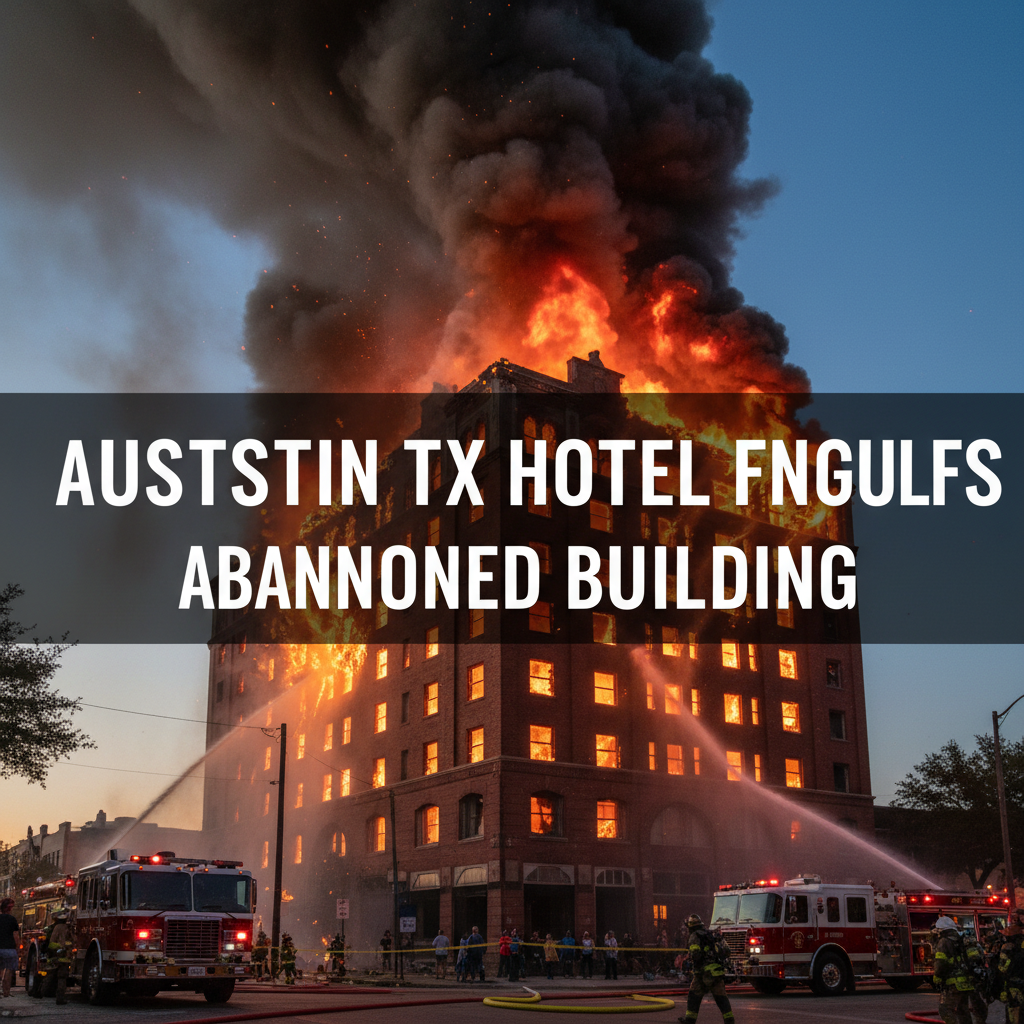Austin TX Hotel Fire Engulfs Abandoned Building
Estimated reading time: 5 minutes
- Major fire broke out at an abandoned building near the University of Texas.
- Casulo Hotel suffered damage estimated at $3 million.
- Over 20 residents displaced, with at least one rescue from a rooftop.
- The multi-alarm response involved over 120 firefighters.
- The cause of the fire remains undetermined.
Table of Contents
- Location and Timeline of the Blaze
- Firefighting Response
- Impact and Damage Assessment
- Cause of Fire
- Recovery and Ongoing Risks
- Media Coverage and Community Response
- Conclusion
Location and Timeline of the Blaze
The fiery ordeal began in a three-story abandoned building located in the 2900-3017 block of South I-35 frontage road. Firefighters were alerted to the blaze early Wednesday morning, and the flames raged on into Thursday, as crews worked tirelessly to address hotspots and structural concerns that arose from the inferno (KUT).
The fire’s intensity necessitated a significant firefighting response, escalating quickly to four alarms, indicating an exceptionally serious situation. Over 120–130 firefighters from the Austin Fire Department and additional emergency services were deployed to combat the blaze and prevent further spread (Fox 7 Austin).
Firefighting Response
As the situation worsened, firefighting efforts intensified. A total of 62 firefighters were actively engaged in the central Austin response, while 36 units were dispatched to both the hotel and surrounding buildings affected by the fire. This large-scale operation was essential for containing the blaze amid spinning winds that aggravated the fire’s progression (KUT).
Firefighters were also harnessing modern technology by using drones, which allowed them to search for hotspots and evaluate the structural integrity of the collapsed building without risking personnel. This tactical adaptation highlights the innovation in emergency response strategies employed by firefighting teams (Fox 7 Austin).
Impact and Damage Assessment
The Casulo Hotel, which was operational and undergoing renovations at the time, suffered considerable damage, with estimates of losses approaching $3 million. Structural collapses occurred on the second and third floors, rendering the building officially uninhabitable and unsafe for entry. The heavy smoke produced by the fire could be seen from various locations throughout Austin, including Zilker Park during the bustling Austin City Limits Music Festival (CBS Austin).
This disaster resulted in the displacement of over 20 residents and hotel guests, some of whom tragically lost all their possessions in the blaze. In a harrowing moment, at least one individual had to be rescued from the rooftop by a friend to avoid the flames (CBS Austin). Fortunately, the injuries were limited to one firefighter who sustained a second-degree burn, with no civilian injuries reported (Fox 7 Austin).
Cause of Fire
The cause of the fire remains officially undetermined, primarily due to the total destruction of the building of origin and the instability presented by the remaining structure. Strong winds played a pivotal role in spreading the flames rapidly, resulting in embers from the abandoned building igniting the Casulo Hotel. This incident underscores the vulnerability of urban areas where abandoned buildings can pose significant risks (Fox 7 Austin).
As firefighters battled the blaze, Austin Energy coordinated efforts by shutting off electricity in the vicinity to reduce the risk. The area remains under evaluation for structural hazards, and officials continuously monitor for any lingering hotspots (KUT).
Recovery and Ongoing Risks
The aftermath of the fire has left many questions unanswered, especially regarding safety measures for abandoned buildings in urban settings. City officials are now faced with the challenge of ensuring the safety of surrounding structures and the welfare of displaced residents. Community support initiatives have begun to emerge as local organizations rally to assist those affected by the disaster.
The ongoing investigation will focus not only on determining the cause but also on assessing preventative measures that can be adopted to mitigate similar occurrences in the future. Local authorities are left evaluating emergency preparedness protocols and the overall management of abandoned properties in densely populated urban areas like Austin (CBS Austin).
Media Coverage and Community Response
The fire has garnered significant media attention, with coverage spanning local news outlets, radio stations, television networks, and social media platforms. Eyewitness accounts and interviews with displaced residents have stressed the human element of this disaster, detailing personal losses and the swift action of emergency responders (KUT).
As public awareness of this incident grows, community members are stepping up to provide aid. Many organizations are anticipated to begin fundraising efforts aimed at helping displaced residents, highlighting the resilience and solidarity of the Austin community during this challenging time (Fox 7 Austin).
Conclusion
The Austin hotel fire serves as a stark reminder of the ever-present dangers associated with abandoned buildings and urban environments. While the immediate response was commendable, the community’s focus needs to shift towards recovery, structural safety, and long-term solutions to ensure that such tragedies do not disrupt lives again. The road ahead will require collective efforts to address not only the physical damages incurred but also the support for those whose lives have been forever changed.
As the investigation continues and recovery efforts unfold, many will be looking to local governance to implement changes that can prevent a repeat of this devastating event in Austin and beyond.
For more trending news, visit NotAIWorld.com.
FAQ
- What caused the fire?
- How many people were affected by the fire?
- What steps are being taken for recovery?
- How is the community responding?
- What was the firefighting response?
